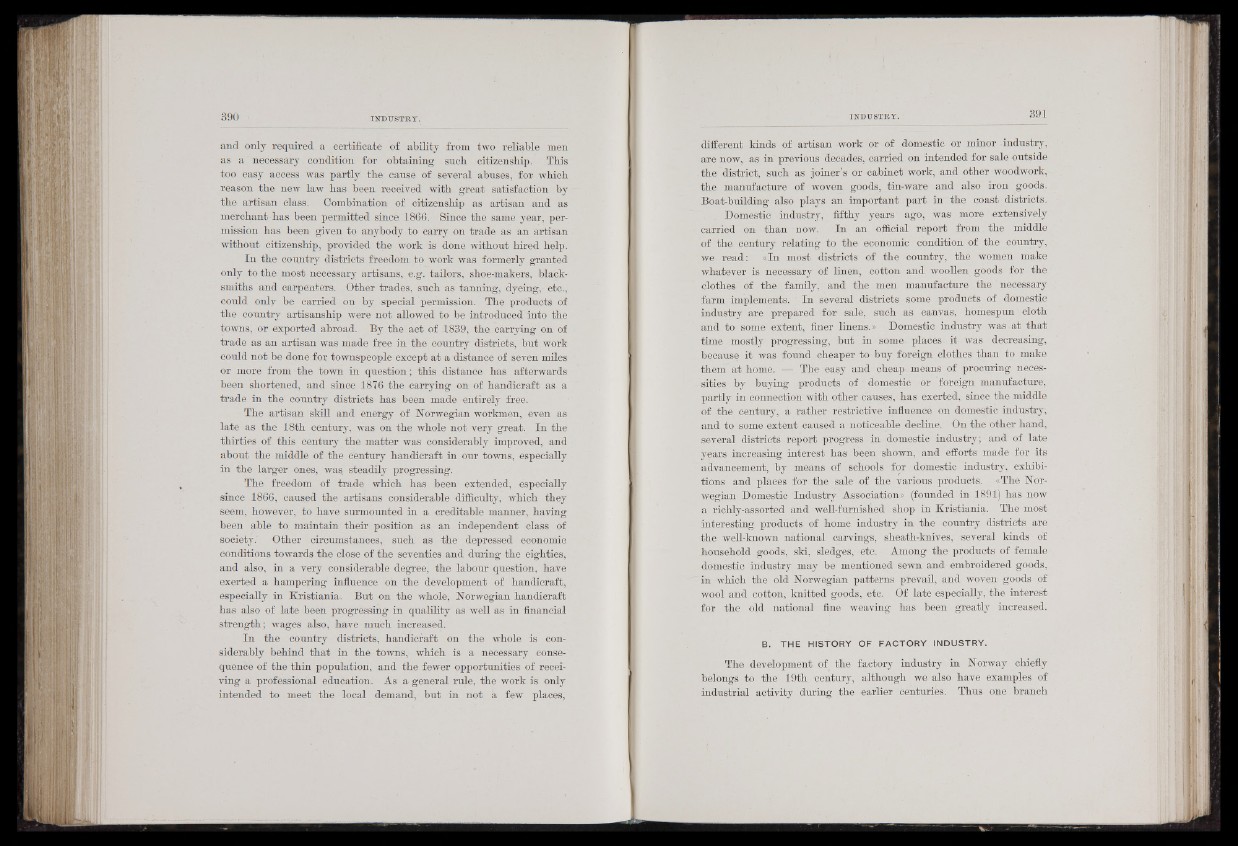
and only required a certificate of ability from two reliable men
as a necessary condition for obtaining such citizenship. This
too easy access was partly the cause of several abuses, for which
reason the new law has been received with great satisfaction by
the artisan class. Combination of citizenship as artisan and as
merchant has been permitted since 1866. Since the same year, permission
has been given to anybody to carry on trade as an artisan
without citizenship, provided the work is done without hired help.
In the country districts freedom to work was formerly granted
only to the most necessary artisans, e.g. tailors, shoe-makers, blacksmiths
and carpenters. Other trades, such as tanning, dyeing, etc.,
could only be carried on by special permission. The products of
the country artisanship were not allowed to be introduced into the
towns, or exported abroad. By the act of 1839, the carrying on of
trade as an artisan was made free in the country districts, but work
could not be done for townspeople except at a distance of seven miles
or more from the town in question; this distance has afterwards
been shortened, and since 1876 the carrying on of handicraft as a
trade in the country districts has been made entirely free.
The artisan skill and energy of Norwegian workmen, even as
late as the 18th century, was on the whole not very great. In the
thirties of this century the matter was considerably improved, and
about the middle of the century handicraft in our towns, especially
in the larger ones, was. steadily progressing.
The freedom of trade which has been extended, especially
since 1866, caused the artisans considerable difficulty, which they
seem, however, to have surmounted in a creditable maimer, having
been able to maintain their position as an independent class of
society.' Other circumstances, such as the depressed economic
conditions towards the close of the seventies and during the eighties,
and also, in a very considerable degree, the labour question, have
exerted a hampering influence on the development of handicraft,
especially in Kristiania. But on the whole, Norwegian handicraft
has also of late been progressing in qualility as well as in financial
strength; wages also, have much increased.
In the country districts, handicraft on the whole is considerably
behind that in the towns, which is a necessary consequence
of the thin population, and the fewer opportunities of receiving
a professional education. As a general rule, the work is only
intended to meet the local demand, but in not a few places,
different kinds of artisan work or of domestic or minor industry,
are now, as in previous decades, carried on intended for sale outside
the district, such as joiner’s or cabinet work, and other woodwork,
the manufacture of woven goods, tin-ware and also iron goods.
Boat-building also plays an important part in the coast districts.
Domestic industry, fifthy years ago, was more extensively
carried on than now. In an official report from the middle
of the century relating to the economic condition of the country,
we read: «In most districts of the country, the women make
whatever is necessary of linen, cotton and woollen goods for the
clothes of the family, and the men manufacture the necessary
farm implements. In several districts some products of domestic
industry are prepared for sale, such as canvas, homespun cloth
and to some extent, finer linens. » Domestic industry was at that
time mostly progressing, but in some places it was decreasing,
because it was found cheaper to buy foreign clothes than to make
them' at home. — The easy and cheap means of procuring necessities
by buying products of domestic or foreign manufacture,
partly in connection with other causes, has exerted, since the middle
of the century, a rather restrictive influence on domestic industry;
and to some extent caused a noticeable decline. On the other hand,
several districts report progress in domestic industry ; and of late
years increasing interest has been shown, and efforts made for its
advancement, by means of schools for domestic industry, exhibitions
and places for the sale of the various products. «The Norwegian
Domestic Industry Association» (founded in 1891) has now
a richly-assorted and well-furnished shop in Kristiania. The most
interesting products of home industry in the country districts are
the well-known national carvings, sheath-knives, several kinds of
household goods, ski, sledges, etc. Among the products of female
domestic industry may be mentioned sewn and embroidered goods,
in which the old Norwegian patterns prevail, and woven goods of
wool and cotton, knitted goods, etc. Of late especially, the interest
for the old national fine weaving has been greatly increased.
B. THE HISTORY OF FACTORY INDUSTRY.
The development of the factory industry in Norway chiefly
belongs to the 19th century, although we also have examples of
industrial activity during the earlier centuries. Thus one branch